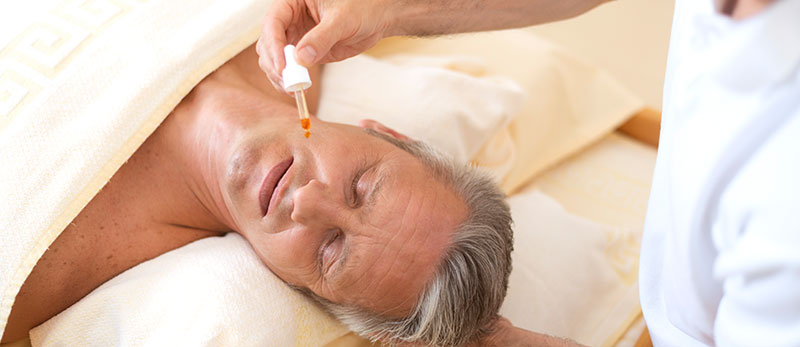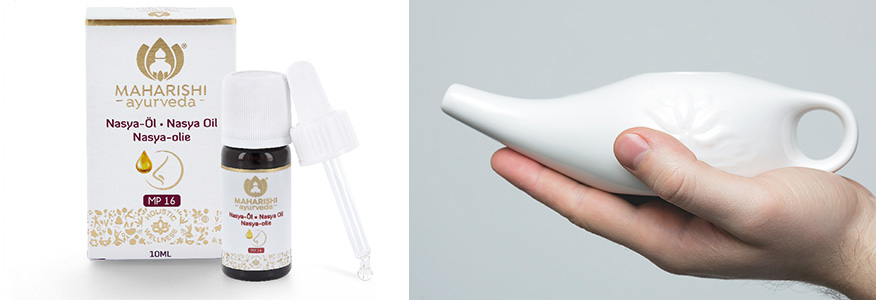Nasya is a Sanskrit word, meaning: to eliminate or banish diseases and disorders of the head. For this purpose, medicated oils, Ghee, vapors or powders are administered into the nose.
- Nasya plays a central role in Panchakarma and is one of the five major purification therapies:
- Vamana – therapeutic vomiting (rarely prescribed in Europe)
- Virechana – purgation
- Basti – medicated enema
- Nasya – nasal treatment
- Raktamokshana – bloodletting
The nose is considered the gateway to our consciousness, through which the life force Prana flows into our body in the form of breath. This is why the many breathing exercises described in yoga are called Pranayama.
Prana is crucial for sensory and motor functions in the body and supports healthy brain activity. Disruption of Prana can cause headaches, spasms, impaired sensory perception and memory loss.
Nasya upholds the healthy flow of Prana and cleans numerous small bodily pathways that are closely connected with the brain and the spinal cord.
Therefore, Nasya is a key Ayurvedic purification method and an integral part of a complete Panchakarma course of treatment. Although only the nose is treated, Nasya has a broad range of action: it can bring balance to the Doshas throughout the body and is particularly beneficial for the head area: throat, thyroid gland, sinuses, eyes and ears, and last but not least, the brain.
After all, the nerve cells of the olfactory system, our sense of smell, are located in a small area in the roof of the nasal cavity, where millions of olfactory cells are located. Via the olfactory nerve, their signals are directly transmitted to various areas of the brain, to be processed and combined there. Because of this anatomical peculiarity, the nasal mucosa uniquely provides direct access to the brain – a pathway for effective stimulation or calming down.

Indications for nasal treatment
Nasya can be recommended primarily for the following conditions:
- Chronic headache and migraine, because of its dilating effect on blood vessels in the brain
- Allergic diseases of the upper respiratory tract – Nasya reduces inflammation and swelling
- Chronic nasal congestion and blocked sinuses – Nasya dissolves and removes excess Kapha, for example in the form of mucus
- Dry, irritated nasal mucous membranes – oils or Ghee applied there have a soothing effect
- General cases of sinusitis, rhinitis, bronchitis, and asthma
- Thyroid diseases – because of the improved blood circulation also in these tissues
- Neurological disorders, such as Parkinson’s, or post-stroke conditions – Nasya strengthens the coordination between motor and sensory functions, as well as the flow of Prana and blood to the brain
- Other neurologic disturbances, like tingling or paralysis in the upper part of the body
- Problems with memory and concentration
- Sleep disorders
- Tinnitus
Contra-indications – when not to apply Nasya:
- immediately after meals
- immediately after taking a bath
- in case of strong hunger, thirst or exhaustion
- in case of fever
- in case of an acute nosebleed
- in young children and elderly people who feel weak
- during pregnancy
- during the menstrual period
Besides being applied during a Panchakarma course of treatment, Nasya can also be done at home. This can take the form of a quick oiling of the nasal mucosa during your daily morning routine, a nose-rinse with a Neti pot, or an extensive cleaning session.

Nasya as a part of your morning routine.
An Ayurvedic daily routine, Dinacharya, starts the day with nose care alongside other things like oral care (scraping the tongue, brushing the teeth, oil pulling) and self-massage.
Integrated into your daily Ayurvedic body care routine, Nasya can prevent diseases of the head area and has a beneficial effect on existing disorders, e.g. allergic rhinitis and a tendency to headaches. High-quality oils nourish the nasal mucosa, are antibacterial, decongestant, moisturizing and regenerating. Suitable are, for example, sesame oil, Ghee, or the special nasal oil MP16 from Maharishi Ayurveda Europe, which contains numerous herbs and spices in a base of sesame oil.
The oils can be applied as follows:
With your head tilted back, insert 1–3 drops of oil per nostril and sniff up. Do this daily, or several times a day.
Apply oil on the tip of your little finger and gently oil the inside of the nose. Do this in the morning and in the evening.
Rinse your nose using a Neti pot filled with salt water, then apply 1-3 drops of nasal oil to complete the treatment.

Comprehensive Nasya treatment at home
For acute problems as well as the chronic conditions listed above under ‘indications’, Ayurveda recommends Nasya.
Naturally, all treatments have a more profound effect if they are carried out regularly over a longer period of time. This is also true for Nasya, which has an especially strong transformative effect if applied after a series of Panchakarma treatments, when the body cells in general and the intestines in particular have already been cleansed.
For doing a comprehensive Nasya at home you need:
A large bowl of hot water, a towel, Nasya oil, a pipette, a small empty bowl, half a liter of warm drinking water.
Procedure
- To enhance the effect of the oil and to prepare the mucous membranes optimally, start with a 10-minute inhalation. Sit with your head over a bowl of hot water, keeping the heat and the vapor in by closing off the space with the towel. Breathe easily, inhaling through the nose and exhaling through the mouth. The effect of the inhalation can be further increased if you put 1–2 drops of a natural essential oil, such as thyme, rosemary, or MA 634 into the hot water.
- In the second step, the Nasya oil is applied. To do this, lie on your back and stretch your head back a little. Slowly and carefully drip 5–10 drops of nasal oil into each nostril. (The easy way to apply the oil is to use a pipette, available in pharmacies, and included in the MP16 nasal oil.) After each drop, insert a little pause to observe the effect. As always in Maharishi Ayurveda – and especially when doing self-treatment at home – everything should feel pleasant and gentle.
After the oil is starting to run into your throat, sit up carefully and spit out the oil and the mucus that is being dissolved into the empty bowl. Then rinse the mouth with warm water and clean the throat by gargling. - As a last step, drink 1-2 glasses of warm water and rest quietly for at least 15 minutes. Make sure you stay in a warm room and wrap your head and forehead in a warm towel. After steam bath and Nasya, stay inside for at least 3 hours in a comfortably tempered house and also protect yourself from wind and cold for the rest of the day.
After a successful nose treatment you will feel relieved, clear and liberated. Try it out for yourself and share your experiences in the comments!
Your Maharishi Ayurveda Team from Bad Ems
Download the article as a PDF file
© Maharishi Ayurveda Health Centre Bad Ems